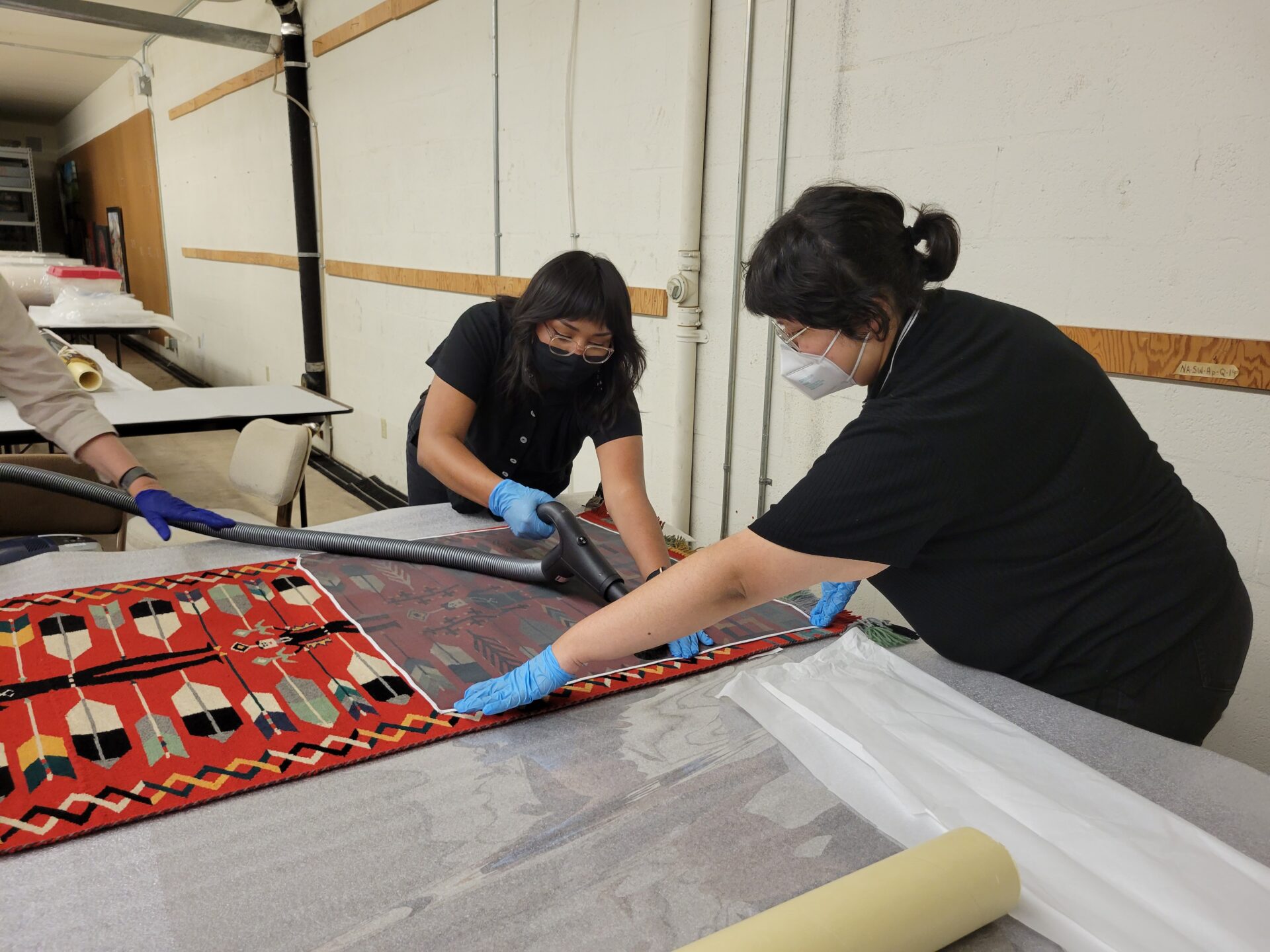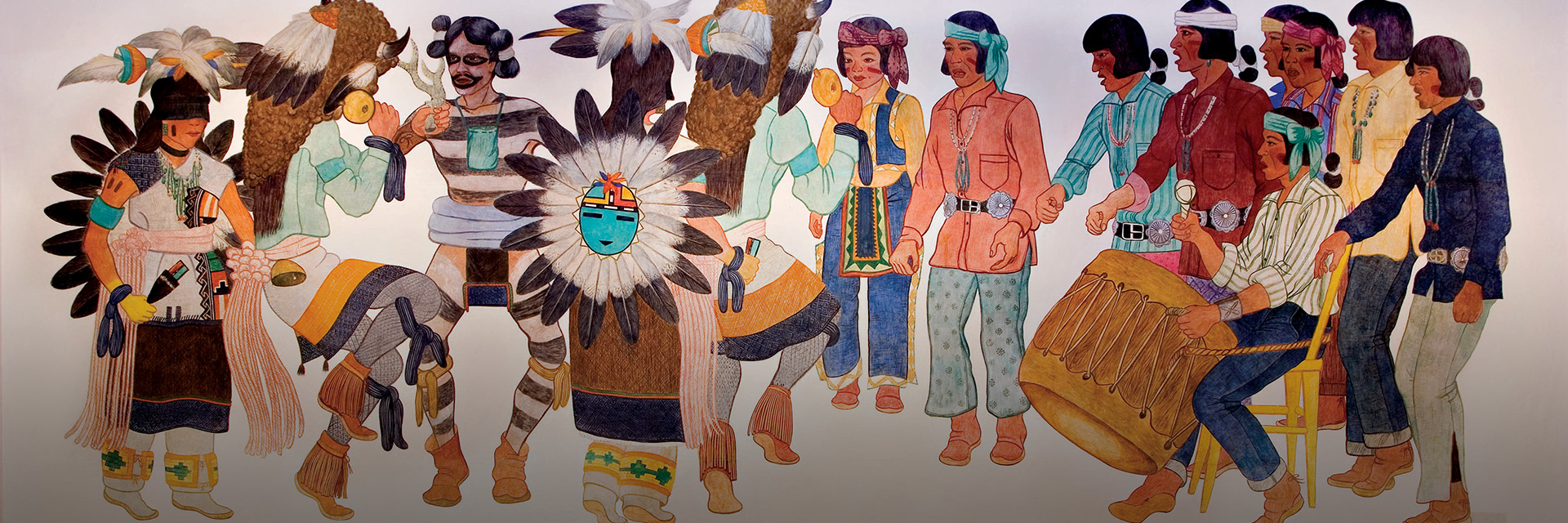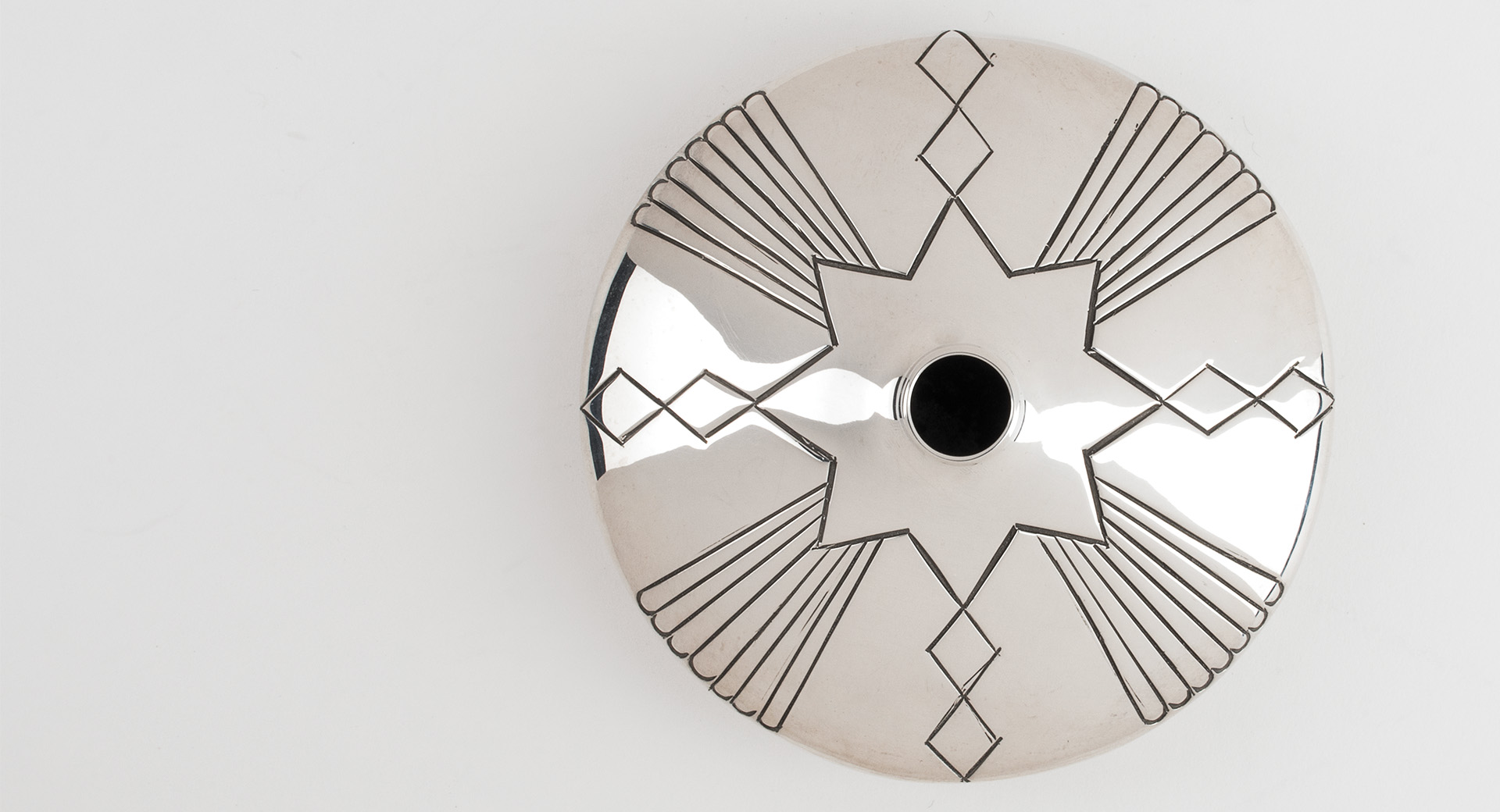On view through Sept. 26, 2021, All at Once: The Gift of Navajo Weaving showcases 46 exquisite textiles from contemporary Navajo weavers. All at Once has been made possible by the generous donation of longtime Heard Museum members and supporters Mark and Julie Dalrymple (see page 22 to read an article from Julie). These textiles, plus dozens more, now reside in the Heard Museum’s permanent collection. Also featured throughout this exhibition are artist statements from leading Navajo weavers including Marlowe Katoney, Marilou Schultz and sisters Barbara Teller Ornelas and Lynda Teller Pete. All at Once was curated by Dr. Ann Marshall, Director of Research, in collaboration with Velma Kee Craig, Assistant Curator, and the Andrew W. Mellon Fellows: César Bernal (Chicanx), Roshii Montano (Diné) and Ninabah Winton (Diné). Continue reading for personal reflections from Kee Craig and the Mellon Fellows about their time creating and curating this exhibition.
Velma Kee Craig, assistant curator
At the end of 2019, the Heard Museum received a large donation of textiles from Mark and Julie Dalrymple, collectors and longtime Heard supporters. At that time, I was midway through my third season as an Andrew W. Mellon Fellow. I remember the excitement as the 2019-2020 Fellows and I first encountered the nearly 90 textiles as they lay stacked in neat piles on tables in the museum basement. We dove immediately into surveying each individual textile, incomplete awe of the diversity of styles represented in this batch of weavings. As we laid out each textile for the team to discuss, one of us would read aloud the accompanying information, beginning with the assigned ID number, weaver’s name, the title of the weaving (if the weaver had given it one) and the type of design. Having this information to accompany the textiles was such a treat for us.
Two of us, Ninabah Winton and I, had just wrapped up working on the exhibition Color Riot! How Color Changed Navajo Weaving, in which all but the handful of textiles included in the“Still Rioting” or contemporary section of that exhibition were woven by people whom we labeled as Unidentified Artists. Time and again, we heard ourselves express out loud how we wished we could reach out to the makers of these masterfully woven Transitional-era textiles to get insight into their process, their design inspiration(s), and the story or meanings behind the design or included elements—or even just to know who the weavers were and what region they called home. With this new batch of donated textiles—the Dalrymple Collection—we recognized immediately the opportunity we had to center the weaver’s voice in the upcoming exhibition, and we began reaching out.
One of the more memorable conversations I had was with weaver Elverna Van Winkle. For Van Winkle, weaving allowed her a freedom to “pick up and go anytime and take work with me.”The most exciting part of the weaving process for her is seeing the design come to life on the loom, as she believes it is for all weavers. We also talked about her late grandmother, Nellie Joe, who taught Van Winkle to weave when she was just 6 or 7 years old. She became emotional when she relayed to me her grandmother’s words, “You should always have a rug setup and on the side to fall back on,” and expressed the gratitude she felt at knowing she has been able to fulfill this wish.
Elverna Van Winkle (Diné), b. 1968, Revival textile, commercial wool, anilinedyes. Collected in 2013. Gift of Mark and Julie Dalrymple, 4951-15.
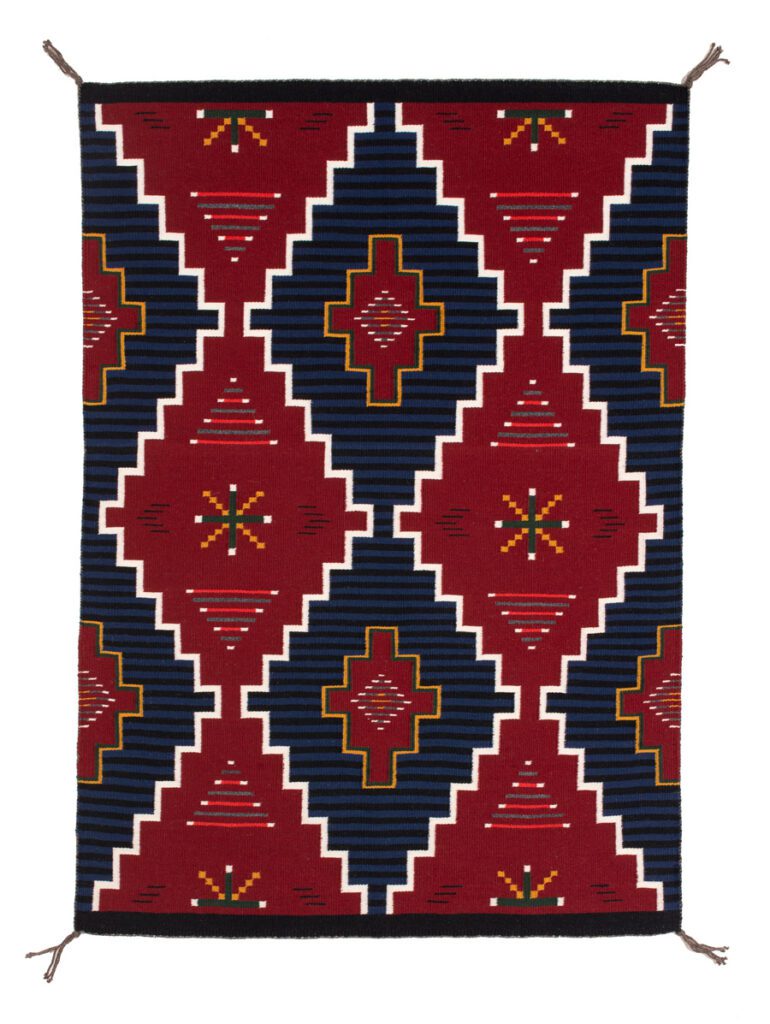
It’s hard to narrow down my choice for “favorite” textile, but I’ve settled on Salina Dale’s impressive and exciting reinterpretation of the classic Two Grey Hills design. Dale’s version has the central diamond medallion turned inside-out or rearranged so that it is instead four triangles pointed toward the center to create an X. At the age of 86, Dale is a master. Her textile and her dissection and reinvention of an age-old classic Navajo design bring me joy.
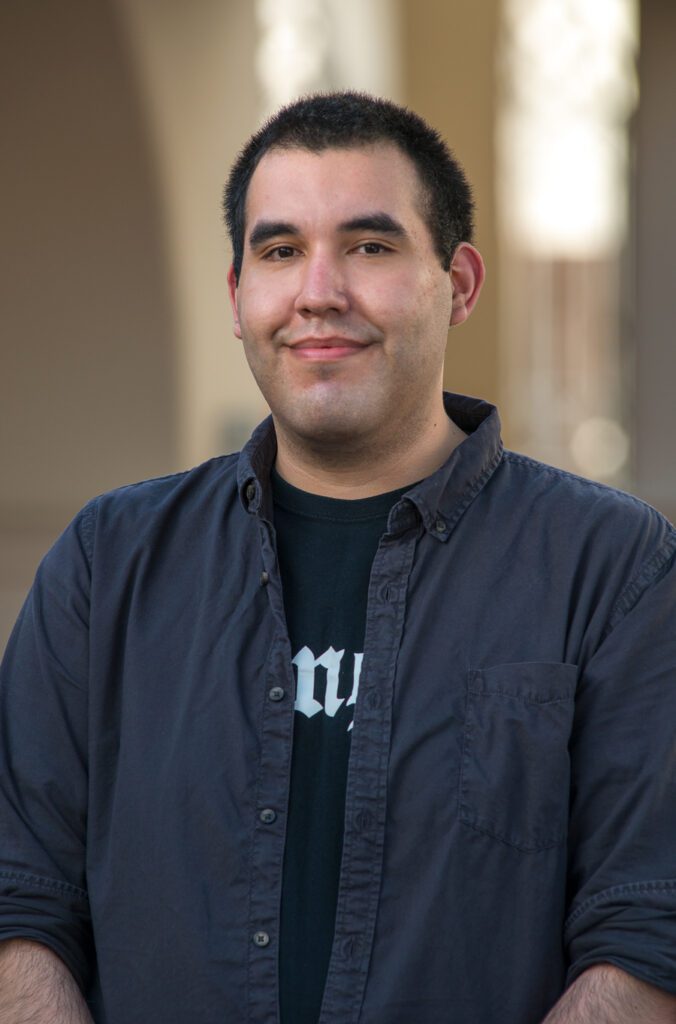
César Esteban Bernal, Andrew W. Mellon Fellow and co-curator
When stepping into museum spaces, what intrigues me the most—besides my interest in what is being exhibited—is the question “How did this come to be exhibited?” This curiosity of mine was satisfied as an Andrew W. Mellon Fellow at the Heard Museum helping with putting together All at Once: The Gift of Navajo Weaving. It was exciting to walk into the workroom for the first time this past October, seeing the entire collection rolled up, and going through each and every textile as we unrolled them and discussed where they could go in the exhibition. Everything up to the point of hanging the textiles on the gallery walls, from learning about the process in conceiving this project to preparing for installation, was exactly the knowledge I was missing when walking into exhibition spaces before.
As I had the opportunity to closely look at every textile, I grew fond of one in particular. A cornstalk pictorial by Charlotte Begay quickly stood out to me. What I really admire about this weaving, and what caught my eye first, is the attention to detail that is placed into the illustration of the birds that line both sides of the cornstalk. Compared with other representations of birds in weavings, these are finished with a more realistic touch. You can see where each feather on the wings and tails of the birds starts and ends. Every bird has its own distinct color markings, and that one thread of yarn that comes up for the eyes brings each of them to life. The cornstalk also has a dimension to it where you can see the depth of the space with the leaves extending back and to the side; it is not merely lying flat. Through viewing it more, the weaving takes the form of a digital rendering in my eyes, as the color shifts become pixelated. This is definitely a favorite of mine among a collection of great works.
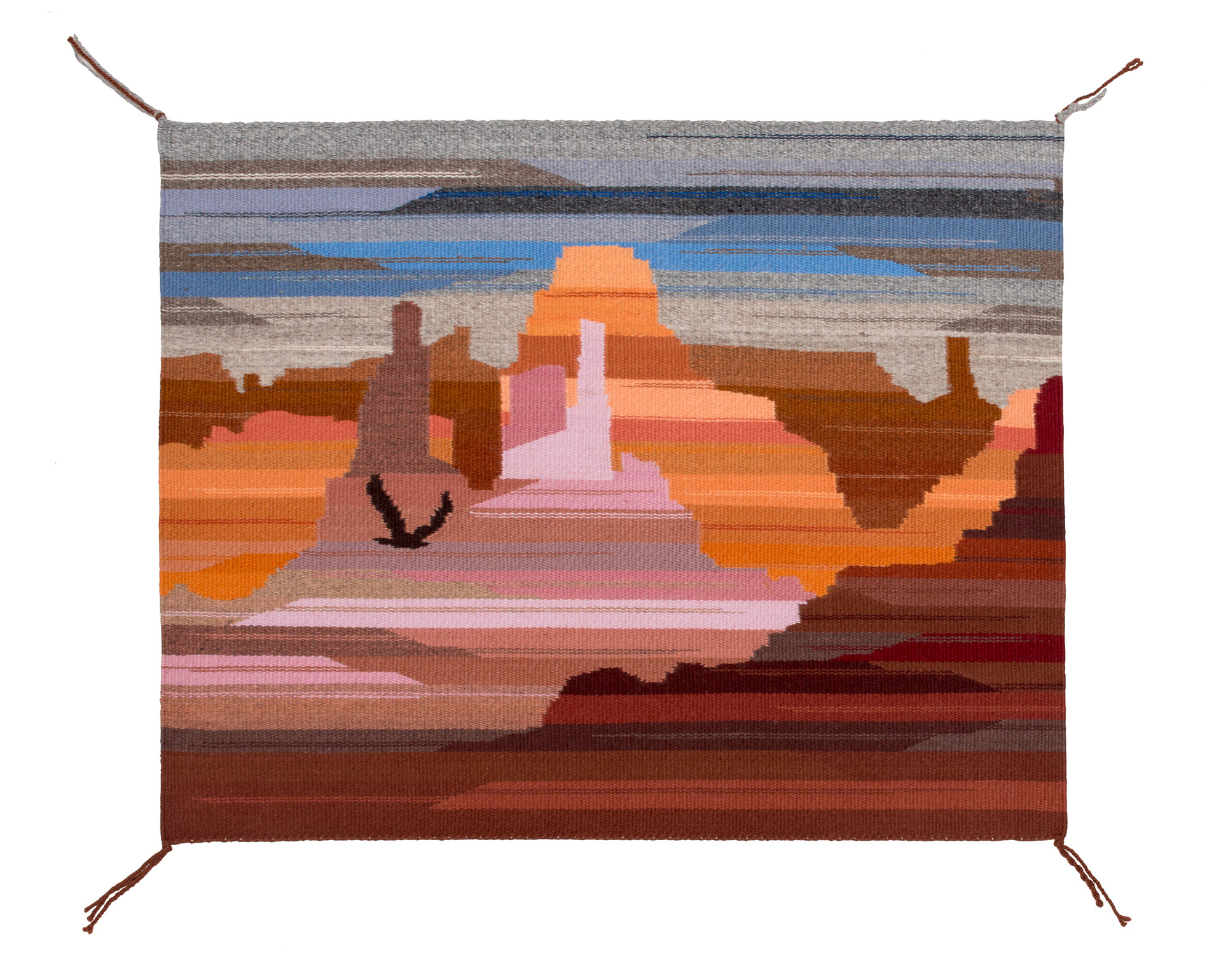
Ninabah Winton, Andrew W. Mellon Fellow and co-curator
Working on All at Once has been very different from our work on our last project as MellonFellows (Color Riot!, 2018).
For parts of 2020 and throughout the process, working on this exhibition has meant working from home, researching and sourcing information—calling and emailing weavers, trading posts, and galleries—while also enduring the doldrums of the pandemic at the same time.
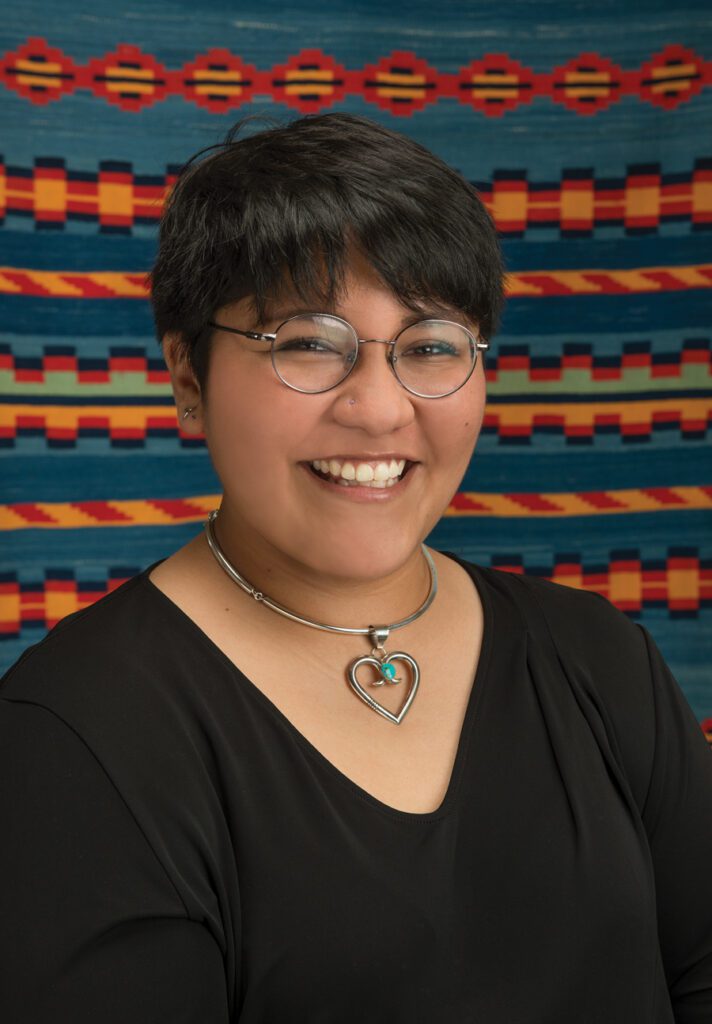
When we did return to the museum, meetings and discussions on the textiles were very different, of course. During textile review sessions, we were unable to fully lean in and huddle over shared magnifying glasses as we once had; we weren’t always able to hear every word of each other’s insights beneath masks and face shields; the exhibition installation was much less populated; and all of the accompanying programming has been moved online.
The whole experience has made me acutely homesick and longing fora place I can’t be right now. For that reason, I find myself drawn to two textiles within the exhibition in particular that evoke a very strong sense of time and place: Canyonland Flight by Michele Laughing-Reeves and a pictorial textile by Angelena Jackson.
Each reminds me of a place I know—climbing amongst canyon bluffs, committing the colors of a landscape to memory, or even the warmth of home after a much too hectic day of sheepherding. Ahxéhee’to all of the weavers for sharing their visions and works with us.
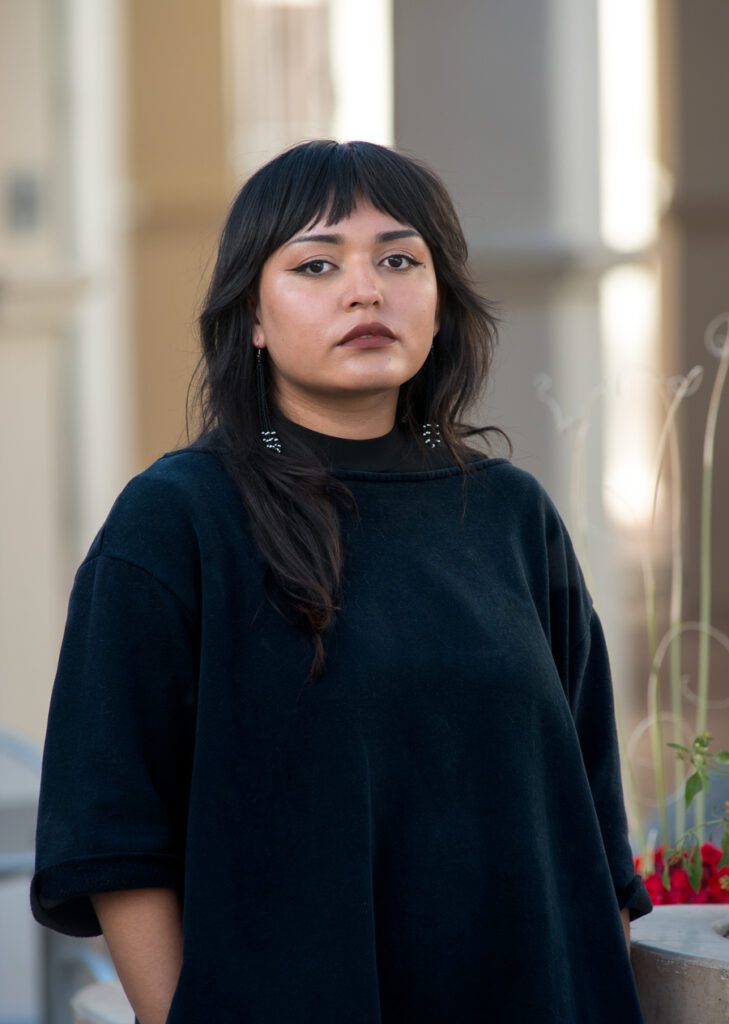
Roshii Montano, Andrew W. Mellon Fellow and co-curator
I joined the Heard Museum through the Andrew W. Mellon Fellowship in early October, after graduating with my B.A. in art history from Stanford University. It has been a bizarre experience having to enter the fellowship during a global pandemic. Even though I’m new to the museum, I think that, no matter our experience, many of us have had to overcome similar challenges. There had already been a lot of work done on the exhibition before I was introduced to the project. I’ve never co-curated an exhibition of this scale. Working on All at Once: The Gift ofNavajo Weaving was truly a unique and collaborative experience. I honor the knowledge thatI’ve gained from this project—working closely with the weavers’ work, their personal statements, and the discussions that arose within the curatorial team.
It’s difficult to pick a favorite piece from the exhibition. When you’re in the room with the other curators thinking about the story you’re trying to tell or themes to bring out, you advocate for certain works to be included in the exhibition. I learned from this process that I developed an attachment to a few select works, one of those being the Ye’ii pictorial textile by Aurelia Joe. There’s an otherworldly, space-like aura that emanates from the landscape that there presentational Ye’ii figures inhabit. Multicolored stars are speckled across the sky in colors red, yellow, blue, green and purple. The atmosphere Joe created in her work exemplifies the innovative essence that stands out in contemporary Diné weaving. When I get a quiet moment at the museum, I’ll walk into the Jacobson Gallery to look at the textiles hanging on the walls. I always look to find something new.

